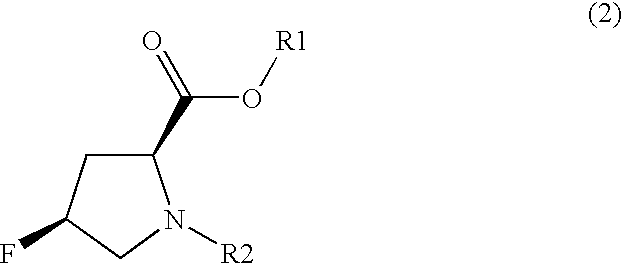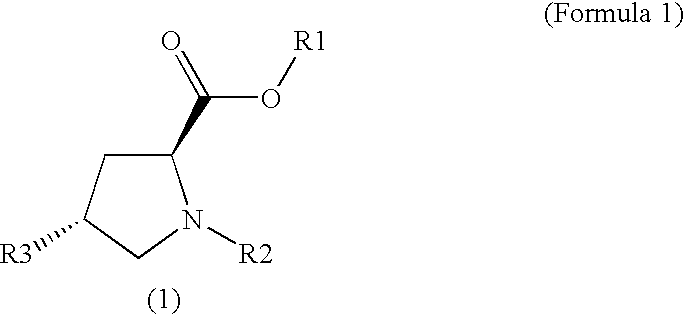Method for Producing Fluorinated Proline Derivative
a technology of proline derivative and fluorinated proline, which is applied in the field of producing fluorinated proline derivatives, can solve the problems of difficult to obtain fluorinated proline derivatives in high purity by recrystallization methods, and achieve the effect of high yield and high efficiency
- Summary
- Abstract
- Description
- Claims
- Application Information
AI Technical Summary
Benefits of technology
Problems solved by technology
Method used
Image
Examples
example 2
Production of FBP
[0188]The reaction in [1] of Example 1 was carried out to obtain a pale yellow syrup (26.1 g) containing 17.5 g (yield rate: 81%) of FBPM (value against calculated FBPM). The pale yellow syrup containing FBPM included 10% by weight of 3,4-DBPM with respect to FBPM and 1.1% by weight of 4,5-DBPM with respect to FBPM.
[0189]FBP as white crystals was obtained by treating the pale yellow syrup (22.7 g) containing 15.2 g as FBPM) in the same manner as the reaction in [2] in Example 1 except for switching the aqueous solution of 11.7% sodium hypochlorite to bromine (3.73 g).
[0190]Yield amount: 11.8 g (value as converted to FBP)
[0191]Yield rate: 82% (value against calculated FBP)
[0192]The melting point and 1N-NMR (CDCl3, 270 MHz) were the same as those in Example 1.
[0193]It was confirmed by the HPLC analysis that both 3,4-DBP and 4,5-DBP which are impurities were 0.01% by weight or less. Meanwhile, the HPLC analytical condition was the same as that in Example 1.
example 3
Production of FBP
[0194]The reaction in [1] of Example 1 was carried out to obtain a pale yellow syrup (26.1 g) containing 17.5 g (yield rate: 81%) of FBPM (value against calculated FBPM). The pale yellow syrup containing FBPM included 10% by weight of 3,4-DBPM with respect to FBPM and 1.1% by weight of 4,5-DBPM with respect to FBPM.
[0195]A reaction solution was prepared by dissolving the pale yellow syrup (1.48 g) (containing 10 g of FBPM) in 10 g of dichloromethane and cooled to 5° C., to which was added dropwise bromine (246 mg). The reaction solution was raised to room temperature and stirred for 4 hours. It was confirmed by the HPLC analysis (HPLC analytical condition 1) that 3,4-DBPM and 4,5-DBPM which are impurities were less than 0.1% by weight with respect to FBPM. The reaction solution was concentrated under the reduced pressure and the resulting residue was dissolved in methanol (2 g), followed by adding an aqueous solution (8.8 g) of 8% sodium hydroxide and stirring at 40...
example 4
Production of FBP
[0200]The reaction in [1] of Example 1 was carried out to obtain a pale yellow syrup (26.1 g) containing 17.5 g (yield rate: 81%) of FBPM (value against calculated FBPM). The pale yellow syrup containing FBPM included 10% by weight of 3,4-DBPM with respect to FBPM and 1.1% by weight of 4,5-DBPM with respect to FBPM.
[0201]FBP as white crystals was obtained by treating the pale yellow syrup (2.27 g) (containing 1.52 g as FBPM) in the same manner as the reaction 2 in Example 1 except for switching the aqueous solution of 11.7% sodium hypochlorite to N-bromosuccinimide (0.53 g).
[0202]Yield amount: 0.92 g (value as converted to FBP)
[0203]Yield rate: 85% (value against calculated FBP)
[0204]The melting point and 1N-NMR (CDCl3, 270 MHz) were the same as those in Example 1.
[0205]It was confirmed by the HPLC analysis that both 3,4-DBP and 4,5-DBP in white crystals were 0.01% by weight or less. Meanwhile, the HPLC analytical condition was the same as that in Example 1.
PUM
| Property | Measurement | Unit |
|---|---|---|
| temperature | aaaaa | aaaaa |
| temperature | aaaaa | aaaaa |
| boiling point | aaaaa | aaaaa |
Abstract
Description
Claims
Application Information
 Login to View More
Login to View More - R&D
- Intellectual Property
- Life Sciences
- Materials
- Tech Scout
- Unparalleled Data Quality
- Higher Quality Content
- 60% Fewer Hallucinations
Browse by: Latest US Patents, China's latest patents, Technical Efficacy Thesaurus, Application Domain, Technology Topic, Popular Technical Reports.
© 2025 PatSnap. All rights reserved.Legal|Privacy policy|Modern Slavery Act Transparency Statement|Sitemap|About US| Contact US: help@patsnap.com



